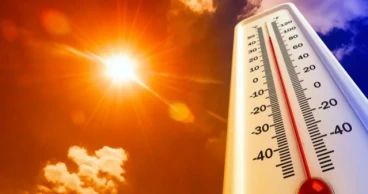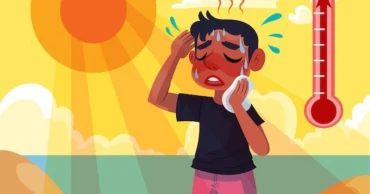Heat Stroke
Heatwave being considered a ‘disaster’: State Minister for Disaster Management and Relief
With temperatures reaching unbearable levels, there is a call from public health experts and meteorologists to officially declare the heatwave a disaster and to establish a comprehensive action plan to address its impacts. Against this backdrop, the Ministry of Disaster Management and Relief says it is considering the ongoing heatwave in Bangladesh as a “disaster”.
During the current summer season, the country has been experiencing a prolonged period of heat, causing widespread disruption to daily life. Instances of heatstroke have led to fatalities, numerous hospital admissions, and significant damage to crops and fruit trees.
In response to inquiries about whether heatwaves should be declared disaster like droughts, State Minister for Disaster Management and Relief Md. Mohibbur Rahman emphasized, “I certainly would call this extreme heatwave a disaster.”
Dhaka’s air ‘unhealthy for sensitive groups’ this morning
The ministry is actively gathering data on the severity of the heat, which has caused various forms of damage, including deaths from heatstroke, illness, and agricultural losses. This information will guide their decision on whether to extend financial and other forms of assistance to those affected, the state minister said.
Secretary Md. Kamrul Hasan of the Ministry of Disaster Management and Relief stated that while the government last declared lightning a disaster in 2016, the suggestion to categorize heatwaves similarly is under consideration. The ministry is collecting data on the highest temperatures and their impacts to determine the next steps.
Public health expert and former director of Disease Control at Directorate General of Health Services, Professor Dr. Be-Nazir Ahmed, warned that the current extreme temperatures pose a serious health risk, potentially leading to outbreaks of diseases like cholera.
Dr. Ahmed advocated for strategic planning to prevent heatwave-related deaths and suggested that such a strategy should aim to make the heat more tolerable, including increasing vegetation and maintaining water bodies as cooling measures.
Rain expected in Chattogram and Sylhet within 24 hours
Dr. Md. Zillur Rahman, Dean of the Faculty of Earth and Environmental Sciences at Dhaka University, stressed that preparation is crucial as average temperatures have risen by one degree Celsius from 2011 to 2020. He noted that the country is experiencing hotter summers and emphasized the need for strategies to adapt to these increasing temperatures.
According to the Meteorological Department, a heatwave is categorized based on temperature ranges, with the highest category being "severe" when temperatures exceed 42 degrees Celsius.
On April 20, 2024, the country recorded its highest temperature of the season at 42.6 degrees Celsius in Jashore, indicating the severity of the current heatwave. Schools remained closed due to the extreme heat following the Eid holiday break.
The ministry and experts are considering implementing national strategies to mitigate the effects of heatwaves, emphasizing the need for a proactive approach to protect public health and ensure economic stability in the face of increasing temperatures.
Read more: Heatwave forces closure of schools until Thursday
1 year ago
Navigating the Risks of Summer Heat: Essential Health Tips for Pregnant Women
Summer is a time of heat and outdoor activities, but for pregnant women, it also brings the challenge of coping with intense heat waves that can pose serious health risks. From dehydration to heatstroke, the heightened vulnerability of expectant mothers requires careful strategies to ensure their health and that of their developing babies. This comprehensive guide explores practical and effective measures to safeguard pregnant women during these critical months.
Understanding the Risks for Pregnant Women in Summer
Pregnancy demands a lot from the body, which is already managing increased blood volume and the energy requirements of carrying a baby. In the summer, these challenges are compounded by higher temperatures and humidity, which can lead to faster dehydration and overheating. This increased susceptibility makes it essential to adopt preventive measures against heat-related health issues.
Hydration: The First Line of Defense Against Heat
Water is a vital ally for pregnant women during hot weather. Staying well-hydrated is crucial, as dehydration can trigger complications such as overheating, urinary tract infections, and even preterm labor. At least 8-10 glasses of water daily are recommended. Using a reusable water bottle makes it easier to stay hydrated on the go.
Read more: How to Travel Safely During Heat Waves
Electrolyte Management
Alongside hydration, maintaining electrolyte balance is critical. Loss of electrolytes through sweating can be significant in summer. Electrolyte-rich drinks or adding a pinch of salt to water can help restore balance.
Natural sources such as coconut water are also beneficial. It is important to check with a healthcare provider before incorporating new items into the diet, particularly if there are underlying health conditions.
Choosing the Right Clothing
Appropriate attire can significantly influence body temperature. Pregnant women should opt for loose, lightweight, and breathable clothing. Fabrics like cotton and linen are ideal as they allow air circulation and help prevent overheating.
Read more: Summer Tips for School-going Children
Light colors are preferable because they reflect sunlight, whereas dark colors absorb it, increasing heat retention. Comfortable, well-fitting shoes are also essential to accommodate swelling in the feet, a common issue during pregnancy.
Sun Protection Strategies
Sun protection is vital for preventing skin damage and managing body temperature. A wide-brimmed hat, UV-protective sunglasses, and sunscreen with at least SPF 30 are key to guarding against the harmful effects of UV radiation.
Limiting Exposure to Extreme Heat
It is advisable for pregnant women to minimize their time spent outdoors during peak heat hours—typically between 10 am and 4 pm. Planning activities during cooler parts of the day, such as early morning or late evening, can reduce the risk of overheating. When outside, staying in shaded areas or using an umbrella can provide immediate relief from direct sunlight.
Read more: How to Protect Outdoor Workers from Heat Stroke
1 year ago
Two teachers die from ‘heat stroke’ amid ongoing countrywide heat wave
Two teachers died possibly from ‘heat stroke’ in Chattogram and Jashore districts on Sunday (April 28, 2024) morning when sever heat wave is scorching the country.
In Chattogram, madasha teacher Maulana Md. Mostak Ahmed Kutubi Alkaderi, 55, fell unconscious while going to his workplacefrom his home in the Mohra area of Chandgaon.
Kutubi Alkaderi, son of late Khalilur Rahman of Kutubdia Lemshikhali in Cox's Bazar district and father of two sons and one daughter, used to work at Khitapchar Azizia Mabudia Alim Madrasha in Boalkhali upazila of Chattogram.
Woman, 2 children electrocuted in Barishal
Witnesses said when the madrasha teacher boarded the ferry at Kalurghat around 9am suddenly he collapsed.
Later, he was taken to Chattogram Medical College Hospital (CMCH) where doctors declared him dead.
In Jashore, Ahsan Habib, an assistant teacher of Ahmedabad High School, died from apparent heat stroke on Sunday in sadar upazila.
AZM Parvez Masud, headmaster of the school, said Habib fell sick around 9 am when he went to school after working in a field.
Two children drown in Rajshahi pond
Later, he was taken to Jashore General Hospital, where a doctor declared him dead.
The body was kept at Jashore General Hospital morgue for autopsy, said Abdur Razzak, officer-in-charge of Jashore Kotwali Police Station.
The reason behind the death will be known after autopsy, he said.
1 year ago
How to Travel Safely During Heat Waves
Summer vacation presents a wonderful opportunity to explore new destinations. However, during the warmer months, soaring temperatures necessitate careful planning to ensure health safety, especially as many people travel for work, medical treatment, or personal reasons. Here are some effective tips for traveling safely during summer heat waves.
Health Risks During Extreme Heat Waves
Heat waves bring a range of health risks, from mild heat cramps and exhaustion to severe, potentially life-threatening heatstroke. Prolonged exposure to high temperatures can lead to dehydration and heat exhaustion, particularly affecting vulnerable groups such as the elderly, children, pregnant women, and those with pre-existing medical conditions.
Recognizing the signs of heat-related illnesses is crucial. Symptoms may include headaches, dizziness, excessive sweating, weakness, nausea, and a rapid heartbeat. If you or someone you are traveling with experiences these symptoms, it's important to seek shade, rest, and rehydrate immediately. In severe cases, medical attention should be sought promptly.
Read more: Summer Tips for School-going Children
How to Stay Safe While Traveling During the Scorching Heat of Summer
Planning Ahead
Before embarking on your summer travels, careful planning is necessary. Check the weather forecast for your destination and schedule activities during the cooler parts of the day, typically early mornings and evenings. Be aware of any heat advisories or warnings and adjust your plans accordingly. Consider whether your accommodation has air conditioning, which can be crucial during heat waves.
Dress Appropriately
Opt for lightweight, loose-fitting clothing made from breathable fabrics like cotton or linen. Light colors, such as white or pastels, reflect sunlight and help keep you cool. Moisture-wicking garments can also reduce sweat and discomfort.
Read more: Summer Drinks: Refreshing Homemade Sherbets to Beat the Heat
Stay Hydrated
Water is vital in the heat. To combat dehydration, a common risk during hot weather, drink plenty of fluids. Carry a refillable water bottle and drink regularly, even if you don’t feel thirsty. Avoid sugary or caffeinated beverages, as they can lead to further dehydration.
1 year ago
Summer Tips for School-going Children
As the summer heatwave continues, the risk of heat exhaustion and dehydration becomes a concern. Like adults, children can suffer from severe heat-related illnesses. Therefore, parents and caregivers should be cautious, especially for school-going children who stay outside the home for hours. Here are some essential summer tips to ensure the well-being of school-going children during the hot months.
How to Keep School-going Children Healthy During Summer Heat Waves
Stay Hydrated
Ensuring children stay hydrated is crucial during a heatwave. Parents and caregivers should encourage children to drink plenty of fluids throughout the day, focusing on water as the primary source of hydration. It would be wise to avoid serving children sugary or caffeinated beverages that can contribute to dehydration.
While leaving for school, it is necessary to provide children water bottles and remind them to take regular sips, even if they are not feeling thirsty. Offer water-rich fruits and vegetables like watermelon, cucumber, and oranges as healthy snacks to help keep children hydrated.
Read more: How to Protect Outdoor Workers from Heat Stroke
Dress Appropriately
Lightweight, loose-fitting clothing of breathable fabrics like cotton or linen can help children stay cool. It is highly recommended to opt for light-coloured clothes that reflect sunlight rather than dark colours that absorb heat.
Furthermore, while staying outdoors children can wear wide-brimmed hats and sunglasses to protect their faces and eyes from the sun's harmful rays.
Seek Shade
Children might need to stay outdoors for diverse purposes, like waiting for a school bus. During such situations, children should be encouraged to seek shade or canopies to minimise direct exposure to the sun.
Read more: How to Protect Your Skin and Hair from Sun Damage
Apply Sunscreen Liberally
Sunscreen application is another crucial aspect of sun protection. Like adults, children can use broad-spectrum sunscreen with a high SPF (Sun Protection Factor) of at least 30. Before going to school or other places, kids need to apply sunscreens generously to their exposed skin, including the face, neck, arms, and legs. Nowadays many reputed brands produce child-friendly sunscreen products.
Sunscreen should be reapplied every two hours, or more frequently if children are swimming or sweating heavily. Parents and caregivers should teach children how to apply sunscreen properly and encourage them to build their sun protection routine.
Plan Outdoor Activities Wisely
While planning schedules for active outdoor games and sports during the warmer months, parents should pay attention to the matter that children stay safe from overheating or sunburn. However, when planning outdoor activities, it's essential to schedule them during the cooler parts of the day, such as early morning or late afternoon, to avoid the peak heat hours.
Read more: Summer Drinks: Refreshing Homemade Sherbets to Beat the Heat
Caregivers should guide children to play in shaded areas, such as parks with plenty of trees, or bring portable shade structures like pop-up tents or sun umbrellas to prevent sunburn and heat-related illnesses.
While playing, sweat should be wiped off immediately. Additionally, encouraging regular play breaks in shaded areas allows children to rest and hydrate. It is essential to prevent heat-related illnesses.
Stay Indoors During Peak Heat
During extreme heat, it is best to stay indoors in air-conditioned or well-ventilated spaces for children to avoid heat-related illnesses. It would be thoughtful for the parents and caregivers to plan indoor activities like board games, arts and crafts, or movie marathons to keep children entertained and safe from the heat.
Read more: Beat Dehydration with These Summer Vegetables
Educate About Heat-Related Illnesses
It is essential to teach children about the signs and symptoms of heat-related illnesses, such as heat exhaustion, heatstroke, dizziness, nausea, rapid heartbeat, etc.
Parents and caregivers should teach children to speak up if they are feeling unwell and remind them of the importance of seeking help from a trusted adult if they experience any symptoms of heat-related illness.
Use Cooling Strategies
Implementing cooling strategies like taking cool showers or baths, using fans or air conditioning, and applying cold compresses to the skin can help children beat the heat and stay comfortable indoors.
Read more: Heat Stroke Prevention: Best foods, drinks to avoid heat exhaustion
Parents and caregivers can freeze damp washcloths or water bottles and place them on pulse points like the wrists, neck, and temples to help lower the body temperature of the children. It can make their mind and body cool after returning home from school or outdoors during the heat waves.
Regular Baths
Bathing plays a vital role in maintaining cleanliness. It is important to avoid allowing children to drink or bathe in ice-cold water during hot weather. Instead, offer them water at room temperature or slightly cool.
When bathing, use water at a comfortable temperature, neither too hot nor too cold, to avoid shocking their system.
Read more: Heat Stroke: Symptoms, First Aid, and Prevention
Stay Connected
Staying connected with children, caregivers, and school staff during a heatwave is essential for assuring everyone's safety. Keep lines of communication open with children, caregivers, and school staff during summer.
Sharing information about heat safety tips and encouraging everyone to look out for each other helps create a supportive environment where everyone can stay cool, hydrated, and healthy during hot weather.
Thus, parents and caregivers can minimise the risk of heat-related illnesses in children at home, community space, school, playground, or other places.
Read more: Guidelines issued for primary schools reopening tomorrow amid heatwave
Bottom Lines
Implementing summer safety for school-going children during a heatwave is paramount to their well-being and health. Parents, caregivers, and school staff can help mitigate the risks associated with hot weather, by prioritising hydration, sun protection, appropriate clothing, and staying cool indoors during peak heat hours.
Educating children about heat-related illnesses and empowering them to recognise signs of distress is equally important. By working together and staying aware, the wellbeing and health safety of school children can be assured during the summer months.
Read more: Mist Fan Buyer Guide and Price Ranges in Bangladesh for 2024
1 year ago
Heatwave alert extended in Bangladesh for 72 hours
The Bangladesh Meteorological Department (BMD) has issued a warning that the ongoing heatwave is likely to persist for 72 hours starting Thursday (April 25, 2024) morning.
The BMD cites increased moisture incursion as a factor contributing to the sustained uncomfortable conditions.
Met office issues heat alert for another 72 hours
This announcement follows earlier alerts issued on April 19 and April 22, as the BMD continues to monitor and respond to the challenging weather patterns affecting the region.
25-year-old dies of heatstroke in Ctg
1 year ago
Mist Fan Buyer Guide and Price Ranges in Bangladesh for 2024
Bangladesh is currently going through mild to severe heat waves. Due to the scorching sun and heat, many people are experiencing heat-related illnesses like dehydration, heat stroke, heat exhaustion, etc. Not to mention, the extremely hot weather has accelerated the sales of air conditioners. However, not everyone can afford AC due to its initial and operational costs. Nowadays, mist fans are gaining popularity as cost-effective cooling gadgets to beat the heat. It can be an affordable solution to stay cool without breaking the bank.
What’s the Difference Between a Mist Fan and an Air Conditioner?
There’s a common marketing trope that mist fans are mini air conditioners. But the truth is that mist fans and air conditioners are different things and they work on different principles.
Mist fans atomize the water and disperse in the air. The dispersed water particles quickly evaporate by absorbing the heat from the surroundings. This rapid evaporation causes a cooling effect, lowering the ambient temperature in the surrounding area.
On the other hand, air conditioners cool an area by removing the heat and humidity from the air. It uses the refrigeration principle to replace the hot air inside in a cyclic manner.
Mist fans can reduce the temperature by 3-4 degrees Celcius in a semi-open or open environment. On the other hand, air conditioners can drastically reduce the temperature as they work best in an enclosed environment.
Though mist fans are not alternatives to ACs, these cooling gadgets can give comfort by cooling the room temperature spreading mists and air.
Read more: Heat Stroke Prevention: Best foods, drinks to avoid heat exhaustion
What to Consider Before Buying a Mist Fan?
There are several things to consider while buying the perfect mist fan. With tons of options available in the market, here’s a list of things you should check before buying one.
Portability and Size
One of the key things to consider is the need for portability of your mist fan. Do you need to move it around or will it remain stationary at one place? Depending on portability, mist fans come in several sizes. It is recommended to choose one that best fits your use case.
Misting Level
The misting capacity is another thing to consider while getting a mist fan. If you plan to use the fan outdoors, it is recommended to buy a fan with a high water reserve and high misting capacity.
Mist Fan Coverage
The size and misting capacity of a mist fan greatly determines the coverage area. If you want to cover a small area, then portable type mist fans can be a great choice. When you want to cover a large area from a stationary position, consider getting a pedestal-type mist fan.
Read more: Heat Stroke: Symptoms, First Aid, and Prevention
Fan Speed and Functions
Mist fans come with different functions at different price points. A basic mist fan may provide different fan speeds but an advanced and more expensive fan may have different wind modes and mist control.
Noise Level
Large mist fans (pedestal type) make a lot of noise which can be problematic for indoor use. If you’re planning to buy a mist fan for your home, it would be wise to go for a portable or a smaller one as they tend to make less noise compared to the large pedestal ones.
Power Source
The power source is another thing to consider while buying a mist fan. For example, if you want to use the mist fan outdoors, it needs to have a battery charge feature. Many indoor mist fans also come with a dual power feature.
Rechargeability
Rechargeable mist fans can work for several hours without electricity. Depending on the specifications, these kinds of mist fans need to be connected to power lines for hours to get recharged. During power cuts and load sheddings, a charged mist fan can spread cool air and mists to keep you cool.
Read more: Summer Heatwave: Here’s How to Keep Children Safe
Durability
The durability of the fan plays an important role, especially if you are planning to use it outdoors. As a rule of thumb, sturdy, metal-built mist fans would be better for outdoor use whereas plastic ones would suffice for indoor conditions.
Additional Features
Many mist fans these days come with additional features like insect repellant, air purification, and even LED lights. You can assess each feature based on your usage.
Price and Warranty
And last but not least, it is recommended to double-check the price and warranty. Additional things to check include user reviews and brand reputation to make sure you’re getting the bang for your buck.
1 year ago
Summer Drinks: Refreshing Homemade Sherbets to Beat the Heat
The scorching heat of summer can be relentless, making it essential to find ways to stay cool and hydrated. While the allure of roadside summer drinks is undeniable, they often come with health risks due to questionable ingredients and hygiene standards. Fortunately, there is a safer and more delicious alternative – homemade sherbets. Let's explore 10 revitalising sherbet recipes to try this summer to fight heat related illnesses.
10 Homemade Sherbet Recipes to Beat Dehydration This Summer
Raw Mango Sherbet
Aam Panna, or raw mango sherbet, is a quintessential summer drink in Bangladesh for combating the sweltering heat packed with both flavour and health benefits. Made from raw mangoes, it presents a tantalising blend of tartness and sweetness. This refreshing beverage is rich in vitamins A and C, essential for maintaining hydration and boosting immunity.
To make Aam Panna, simply blend raw boiled, peeled mangoes with mint leaves, roasted cumin powder, black salt, sugar, and water until smooth. To impart a smoky nuance, consider roasting the mangoes beforehand. Serve chilled over ice for a revitalising treat that not only quenches thirst but also replenishes electrolytes and provides a burst of tropical goodness.
Read more: How to Protect Outdoor Workers from Heat Stroke
Tamarind Sherbet
Tamarind sherbet offers a tangy and refreshing escape from the scorching summer heat. Rich in vitamins and minerals, including vitamin C and potassium it offers a sweet-tart punch. It aids in replenishing electrolytes lost during sweating, thus combating dehydration.
To prepare this invigorating drink, combine tamarind pulp with water, sugar or honey, and a dash of salt. Allow the mixture to steep with a cinnamon stick, then strain and chill before serving over ice. Indulge in the zesty flavour and hydrating benefits of tamarind sherbet to stay cool and refreshed all summer long.
Rose Petal Sherbet
Rose petal sherbet embodies a fragrant and floral essence, offering a delightful respite from summer's heat. While lower in electrolytes than some options, it can provide some hydration and is a lovely source of antioxidants. Rich in antioxidants and vitamin C, it supports hydration and boosts immunity.
Read more: Beat Dehydration with These Summer Vegetables
To concoct this rejuvenating elixir, steep fresh rose petals in water, then strain and mix with sugar or honey and a splash of lemon juice. Serve chilled over ice for a cooling sensation that not only tantalises the taste buds but also replenishes vital fluids lost through perspiration. Sip on rose petal sherbet to invigorate your senses and combat dehydration effortlessly.
Bael Sherbet
Bael sherbet, a summer delight, boasts a unique flavour and impressive health benefits. Made with the pulp of the wood apple (bael), it offers a sweet-tart taste with a hint of citrus. This golden drink is a powerhouse of Vitamin C, supporting immunity and fighting inflammation. But bael truly shines in its role against dehydration.
The pulp is rich in fibre and natural electrolytes, helping your body retain fluids and recover from sweat loss. To create this revitalising drink, simply mash the pulp of a ripe bael with water, strain, and add sugar or honey to taste. A pinch of salt and a squeeze of lemon juice complete this refreshing and rehydrating summer beverage.
Read more: How to Protect Your Skin and Hair from Sun Damage
Watermelon Sherbet
Cool off with watermelon sherbet, a naturally hydrating summer treat. Made with blended watermelon, this refreshing pink drink is packed with water, making it a delicious weapon against dehydration.
Watermelon boasts vitamins A, B6, and C, as well as potassium and lycopene. It supports immunity and healthy vision. The recipe is simple: freeze seedless watermelon cubes, then blend them smooth with a touch of lime juice or honey for extra zing. Enjoy this refreshing sherbet for a hydrating and nutritious summer.
1 year ago
How to Protect Outdoor Workers from Heat Stroke
The scorching heat waves can pose serious health risks, especially for people who stay outdoors for long hours due to occupation. During hot weather situations in summer, people working under the sun may suffer from heat-related illnesses like dehydration, heatstroke, etc. Let’s explore some effective tips to safeguard outdoor workers from the debilitating effects of heat waves.
What is Heatstroke?
Heat stroke is a severe heat-related illness characterised by a body temperature of 104°F (40°C) or higher. It arises when your body overheats and the body's internal temperature regulation system fails, typically due to prolonged exposure to high temperatures or strenuous physical activity and dehydration. It is most prevalent during the summer season.
Immediate medical attention is necessary for heatstroke. If left untreated, it can swiftly lead to damage to vital organs such as the brain, heart, kidneys, and muscles. Delaying treatment exacerbates the damage, heightening the risk of severe complications or even death.
Read more: Summer Heatwave: Here’s How to Keep Children Safe
Symptoms of Heat Stroke
The most common symptoms of heatstroke include:
- High body temperature (above 104°F or 40°C)- Altered mental state, such as confusion or disorientation- Nausea and vomiting- Flushed or red skin- Rapid breathing- Rapid heartbeat.
Read more: Heat Stroke Prevention: Best foods, drinks to avoid heat exhaustion
1 year ago
Beat Dehydration with These Summer Vegetables
As the temperatures soar during the scorching summer months, it becomes increasingly crucial to prioritise hydration. Dehydration occurs when the body loses more fluids than it takes in. Dehydration may lead your body to adverse effects ranging from fatigue and headaches to more severe complications like heatstroke. While it is common knowledge to increase water intake during hot weather, many overlook the hydrating potential of the summer vegetables.
Why Incorporate Summer Veggies into Your Diet
Maintaining adequate hydration levels is crucial for maintaining overall health and well-being. Water is essential for regulating body temperature, aiding digestion, transporting nutrients, and flushing out toxins. Dehydration can lead to a range of adverse effects, including fatigue, headaches, dizziness, and even more severe complications like heatstroke.
By staying adequately hydrated, you can enhance cognitive function, improve physical performance, and support organ function. Make it a priority to drink water regularly throughout the day to ensure optimal hydration and vitality, especially in the summer heat.
Read more: How to Protect Your Skin and Hair from Sun Damage
Summer veggies are rich in diverse vitamins and nutrients. Adding vegetables to regular meals can help you stay hydrated and healthy during the warmer months. Let’s take a look into some nutritious summer veggies to fight dehydration this summer.
Nutritious Summer Vegetables to Beat Dehydration
.
Cucumber
Cucumbers are hydrating vegetables packed with nutrients like vitamins A, B, and C, along with minerals such as potassium and magnesium. With a water content over 95%, they replenish lost fluids and electrolytes, aiding hydration.
Enjoy cucumbers sliced in salads, sandwiches, or refreshing cucumber mint smoothies for a hydrating boost. Incorporating cucumbers into your diet regularly can promote skin health, aid digestion, and support overall well-being. Aim for at least one or two cups of cucumber daily to reap its hydrating benefits.
Read more: Summer Safety Tips for Elderly to Avoid Heat-related Illnesses
Tomatoes
Tomatoes are hydrating vegetables boasting a water content of around 94%. Rich in vitamins A and C, along with antioxidants like lycopene, they support immune function and promote heart health. You may incorporate tomatoes into your diet to enjoy their hydrating benefits.
Try them tossed in salads or sandwiches, blended into soups, or roasted with herbs for a flavourful side dish. It is recommended to include 1 or 2 tomatoes in your meals regularly to hydrate your body and boost your health.
Bell Peppers
Bell peppers, with a water content of approximately 92%, are hydrating vegetables rich in vitamins A, C, and K, as well as antioxidants. They support immune function, promote healthy vision, and reduce inflammation. You can incorporate bell peppers into your meals to enjoy their hydrating benefits.
Read more: 7 Comforting Soups for Upset Stomach
Add them to stir-fries, salads, or stuffed pepper recipes for a colourful and nutritious dish. Experts suggest limiting having one bell pepper in a day in your diet to stay hydrated and nourished, especially during hot weather without causing bloating or gas.
Lettuce
Lettuce varieties like iceberg and romaine are primarily composed of water. It is a hydrating vegetable that provides essential nutrients like vitamins A, K, and C, as well as folate and iron. It supports healthy skin, boosts immunity, and aids digestion.
Try to include lettuce in your diet for hydration and nutrition. Use it as a base for salads, wraps, or sandwiches for a refreshing and low-calorie meal option. Enjoy lettuce regularly to stay hydrated and promote overall well-being, aiming for around or less than two cups of green leaf lettuce per day.
Read more: 5 Mouth-watering Mango Pickle Recipes to Cherish This Summer
Spinach
Spinach, packed with water, is a hydrating vegetable loaded with vitamins A, C, and K, along with iron, potassium and folate. It supports bone health, boosts immunity, and aids in blood clotting.
Add one handful of spinach daily into your diet for hydration and nutrition. Add it to salads, smoothies, or cooked dishes for a nutritious boost. These can help you to stay hydrated and reap its numerous health benefits.
1 year ago



















